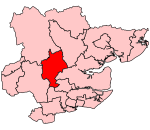Chignall Smealy

Chignal Smealy is a small village and former civil parish, now in the parish of Chignall, on the north-western outskirts of Chelmsford, Essex, England. The local church (St. Nicholas) is a red brick building, containing an unusual red brick baptismal font which has been used for many christenings. In 1881 the parish had a population of 134. On 24 March 1888 the parish was abolished to form Chignall.The village was struck by an F1/T2 tornado on 23 November 1981, as part of the record-breaking nationwide tornado outbreak on that day.The spelling of the village name is open to discussion. Sometimes it is spelt "Chignall Smealy" other times, it is spelt "Chignal Smealy".
Excerpt from the Wikipedia article Chignall Smealy (License: CC BY-SA 3.0, Authors, Images).Chignall Smealy
Chignal Road, Chelmsford Chignall
Geographical coordinates (GPS) Address Nearby Places Show on map
Geographical coordinates (GPS)
| Latitude | Longitude |
|---|---|
| N 51.778 ° | E 0.416 ° |
Address
Chignal Road
CM1 4SZ Chelmsford, Chignall
England, United Kingdom
Open on Google Maps









